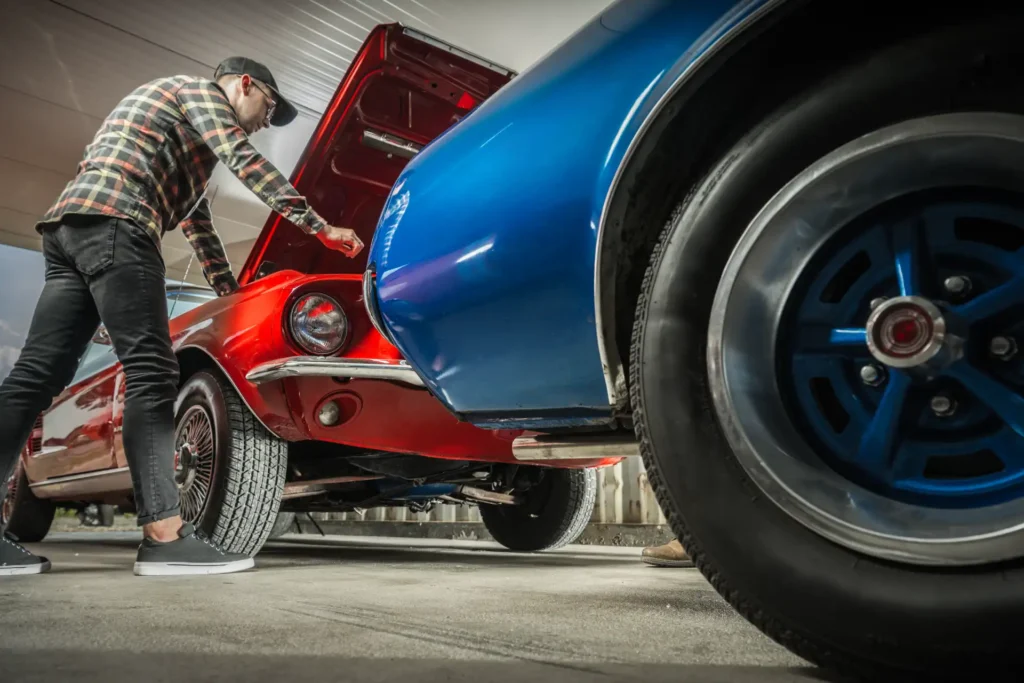In the world of American performance vehicles, two dominant forces stand apart —American Muscle Cars Vs Modern Sports Cars. One symbolizes raw, tire-shredding power and nostalgia. The other delivers precision, speed, and cutting-edge technology.
So which one wins the ultimate showdown?
In this post, we’ll break down the battle of American muscle cars vs modern sports cars, comparing performance, design, technology, and culture — all while spotlighting some of the most iconic models from each era.
💪 What Defines a Classic American Muscle Car?
Muscle cars emerged in the 1960s and 1970s: big-engine, rear-wheel-drive coupes with aggressive styling and affordable price tags. They were built to go fast in a straight line and dominate the drag strip.
🔥 Key Traits:
-
V8 engines (usually 350–450+ HP)
-
Rear-wheel drive
-
Bold, muscular design
-
Built for straight-line speed
🏁 Notable Classic Muscle Cars:
-
1969 Dodge Charger R/T
-
1970 Chevrolet Chevelle SS 454
-
1967 Ford Mustang GT500
-
1971 Plymouth ‘Cuda HEMI
These cars weren’t about refinement — they were about attitude, sound, and brute force.
🧠 What Defines a Modern American Sports Car?
Today’s sports cars blend performance with precision. Think lighter materials, turbocharging, digital tuning, and driver-assist features. They still offer big power — but with control, cornering, and comfort.
⚙️ Key Traits:
-
Advanced engineering (turbo, superchargers, EV tech)
-
Lightweight frames (aluminum, carbon fiber)
-
High-performance suspensions and braking
-
Driver-focused technology and safety
🚗 Notable Modern Sports Cars:
-
2022 Ford Mustang GT500
-
Tesla Model S Plaid (yes, it counts)
These cars are smarter, faster around a track, and often more efficient — but do they have the same soul?
🥊 American Muscle Cars vs Modern Sports Cars: Head-to-Head Comparison
| Category | Classic Muscle Cars | Modern Sports Cars |
|---|---|---|
| Performance | Raw torque & straight-line power | Balanced power with track capability |
| Tech Features | Minimal (analog gauges, no computers) | Advanced infotainment, traction control |
| Handling | Poor in corners, heavy feel | Precision steering, adaptive suspension |
| Design | Aggressive, bold, iconic lines | Aerodynamic, sculpted, tech-inspired |
| Sound | Loud, unfiltered V8 rumble | Refined, sometimes synthetic tones |
| Fuel Efficiency | Low (10–15 MPG) | Improved (20–30 MPG avg) |
| Reliability | Simpler to fix, but less refined | More complex, but often longer-lasting |
| Cultural Appeal | Nostalgic, rebellious, raw | Modern, sleek, performance-focused |
🏎️ Performance Showdown: Muscle Power vs Precision
-
Classic Example:
1970 Chevelle SS 454-
450 HP | 0–60 mph in ~6 seconds
-
¼-mile: ~13 seconds
-
-
Modern Example:
2023 Corvette C8 Z06-
670 HP | 0–60 mph in 2.6 seconds
-
¼-mile: ~10.5 seconds
-
👉 Verdict: Modern sports cars dominate on paper — they’re faster, safer, and more agile. But many enthusiasts argue that classic muscle offers a more visceral, “connected” driving experience.
🎨 Design: Retro vs Futuristic
Classic muscle cars were all about attitude and presence — big hoods, long bodies, and iconic grilles.
Modern sports cars focus on function and form — aerodynamic shapes, digital accents, and performance-enhancing curves.
📌 Fun Fact: Many modern cars, like the Dodge Challenger and Ford Mustang, borrow styling cues from their 60s/70s ancestors — proving that muscle car DNA never really fades.
⚙️ Technology and Features
Classic cars keep things analog — no ABS, no traction control, no power steering (in many cases). That made driving raw and engaging, but also more dangerous.
Modern sports cars are loaded with:
-
Digital dashboards
-
Launch control
-
Adaptive suspension
-
Lane assist & crash avoidance
-
Bluetooth & Apple CarPlay
You’re essentially piloting a supercomputer on wheels.
❤️ Why Enthusiasts Still Love Muscle Cars
Despite their flaws, classic muscle cars offer:
-
Emotional connection: They’re loud, raw, and personal.
-
Mechanical simplicity: Easier to work on and modify.
-
Cultural icon status: Representing freedom, rebellion, and Americana.
-
Collector value: Many increase in value over time.
They’re not just cars — they’re rolling pieces of history.
🚀 Why Modern Sports Cars Are Taking Over
On the flip side, today’s performance cars:
-
Outperform classics in every metric
-
Are more comfortable and practical for daily use
-
Offer incredible power with improved fuel efficiency
-
Bridge the gap between performance and technology
Plus, EVs like the Tesla Model S Plaid are redefining speed entirely — with 0–60 in under 2 seconds.
🔚 Conclusion: Should You Choose Muscle or Modern?
The answer really comes down to what drives you.
-
If you want raw power, nostalgia, and wrench-in-hand weekends — go classic muscle.
-
If you crave speed, tech, and refined performance — modern sports cars deliver in spades.
Or… why not both?
Owning a classic for weekends and a modern for daily thrills might just be the ultimate combo.
